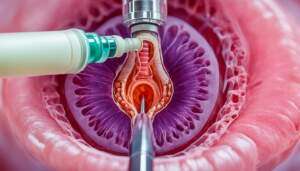If you or someone you know has been diagnosed with esophageal achalasia, you may be wondering about the available treatment options. Esophageal achalasia is a rare swallowing disorder that affects approximately 1 in every 100,000 people. While there is no cure for this condition, there are several treatment approaches that can help manage symptoms and improve your quality of life.
Table of Contents
ToggleIn this article, we will explore different treatment options for esophageal achalasia, both nonsurgical and surgical. It’s important to discuss these options with your healthcare provider to determine the best course of action for your specific condition. Let’s dive in and discover the treatment possibilities that can help you find relief from esophageal achalasia.
When it comes to treating esophageal achalasia, it’s essential to find an approach that suits your needs and preferences. Whether it’s achalasia alternative treatments like pneumatic dilation, Botox injections, or medication, or surgical procedures like Heller myotomy and peroral endoscopic myotomy (POEM), there are options available to help you manage your symptoms effectively.
It’s important to note that early diagnosis and treatment play a crucial role in managing esophageal achalasia. Without timely intervention, symptoms can progress, leading to difficulties with eating and potential weight loss. Therefore, seeking medical attention as soon as possible is highly recommended.
Through this article, we aim to provide you with valuable information to help you make informed decisions about your esophageal achalasia treatment. We’ll discuss the different diagnostic tests, nonsurgical and surgical treatment options, potential complications, long-term management, and the importance of early diagnosis and treatment. By considering the various treatment approaches and understanding their benefits and risks, you can work with your healthcare provider to create a personalized treatment plan.
Diagnosing Esophageal Achalasia
To diagnose esophageal achalasia, various tests may be recommended. These diagnostic tests help determine the type and severity of the motility problem, allowing for an accurate diagnosis and appropriate treatment plan.
Esophageal Manometry
One of the primary diagnostic tests for esophageal achalasia is esophageal manometry. This test measures the muscle contractions in the achalasia of esophagus, providing valuable information about the functioning of the esophageal sphincter and the movement of food into the stomach. During the procedure, a thin tube is inserted through the nose or mouth into the esophagus. The tube is equipped with sensors that measure the pressure and strength of the esophageal muscles as they contract.
X-Rays of the Upper Digestive System (Esophagram)
X-rays of the upper digestive system, also known as an esophagram or barium swallow, can help visualize the esophagus and identify any abnormalities or blockages. In this diagnostic test, you will be asked to swallow a liquid containing barium, which coats the inside of the esophagus and makes it visible on X-ray images. The images captured during the test provide valuable information about the shape, size, and function of the esophagus.
Upper Endoscopy
Another common diagnostic test for esophageal achalasia is upper endoscopy. During this procedure, a thin, flexible tube with a light and camera on the end (endoscope) is inserted through the mouth and into the esophagus. The endoscope allows the doctor to visualize the esophagus directly, identifying any abnormalities, narrowing, or blockages. Biopsies may also be taken during the procedure to rule out other conditions or evaluate the presence of inflammation or infection.
These diagnostic tests – esophageal manometry, X-rays of the upper digestive system (esophagram), and upper endoscopy – play a crucial role in confirming the diagnosis of esophageal achalasia. By providing detailed insights into the functioning and structure of the esophagus, these tests enable healthcare professionals to develop an individualized treatment plan that is tailored to your specific needs.

Nonsurgical Treatment Options
If you’ve been diagnosed with esophageal achalasia, there are several nonsurgical treatment options available to alleviate your symptoms and improve your quality of life. These treatments are especially beneficial for individuals who may not be suitable candidates for achalasia surgery.
Pneumatic Dilation
One nonsurgical treatment option for esophageal achalasia is pneumatic dilation. This procedure involves the insertion of a balloon into the esophageal sphincter, which is then inflated to expand the opening. This helps to improve the passage of food and liquids through the esophagus, relieving swallowing difficulties.
During the pneumatic dilation procedure, an endoscope is used to guide the placement of the balloon. Once the balloon is in position, it is carefully inflated to stretch the esophageal sphincter. This dilation helps to reduce the symptoms of achalasia and improve swallowing function.

Botox Injections
Another nonsurgical treatment option for esophageal achalasia is Botox injections. Botox, which is commonly known for its cosmetic uses, can also be used to relax the esophageal sphincter temporarily. This relaxation helps to ease the passage of food and liquids through the esophagus, improving swallowing function.
The Botox injections are administered directly into the esophageal sphincter through an endoscope. The effects of Botox injections typically last for several months before gradually wearing off. Repeat injections may be necessary to maintain the desired results.
Medication
In addition to procedural treatments, certain medications may be prescribed to help manage the symptoms of esophageal achalasia. Nitroglycerin and nifedipine are commonly used medications that help relax the muscles of the esophagus, making it easier to swallow and reducing the discomfort associated with achalasia.
It’s important to note that medications may not be as effective as pneumatic dilation or Botox injections in treating esophageal achalasia. However, they can be a viable option for individuals who are unable to undergo or prefer not to undergo invasive procedures.
Consult with your healthcare provider to determine the most suitable nonsurgical treatment option for your specific condition. They will consider various factors such as your overall health, symptoms, and individual preferences to guide your treatment plan.
Surgical Treatment Options
A surgical approach may be recommended for individuals with esophageal achalasia who have not responded to nonsurgical treatments or have severe symptoms. The two main surgical options for treating achalasia are Heller myotomy and peroral endoscopic myotomy (POEM). These procedures aim to improve the movement of food through the esophagus and into the stomach.

Heller Myotomy
Heller myotomy is a surgical procedure that involves cutting the muscles at the lower end of the esophageal sphincter, allowing food to pass more easily into the stomach. This procedure can be performed either through traditional open surgery or laparoscopic surgery, which uses smaller incisions and specialized surgical instruments. Laparoscopic Heller myotomy is less invasive and usually results in a faster recovery time.
| Heller Myotomy | Pros | Cons |
|---|---|---|
| Effective in improving swallowing function | Long-term symptom relief | Potential risk of post-operative reflux |
| Performed via open or laparoscopic surgery | Reduced risk of complications compared to open surgery | Potential risk of difficulty swallowing (dysphagia) |
| Potential need for additional acid reflux management |
Peroral Endoscopic Myotomy (POEM)
POEM is a minimally invasive procedure that involves making an incision in the lining of the esophagus and cutting the muscle to improve swallowing function. This procedure is performed using an endoscope, a flexible tube with a camera and surgical instruments attached. POEM offers the advantage of shorter hospital stays, faster recovery times, and minimal scarring.
| Peroral Endoscopic Myotomy (POEM) | Pros | Cons |
|---|---|---|
| Minimally invasive procedure | Faster recovery time | Potential risk of post-operative reflux |
| Shorter hospital stays | Reduced risk of complications compared to open surgery | Potential risk of difficulty swallowing (dysphagia) |
| Minimal scarring | Possible need for additional acid reflux management |
In some cases, a fundoplication procedure may be performed alongside the Heller myotomy or POEM to prevent acid reflux. Fundoplication involves wrapping a portion of the stomach around the lower end of the esophagus to reinforce the lower esophageal sphincter and minimize the chances of stomach acid flowing back up into the esophagus.
Potential Complications of Treatment
While esophageal achalasia treatments are generally safe and effective, it’s important to be aware of potential complications that may arise. These complications can vary depending on the type of treatment received.
Balloon Dilation Complications
Balloon dilation, a nonsurgical treatment option for esophageal achalasia, involves inflating a balloon in the esophageal sphincter to widen the opening. While this procedure is generally considered safe, there is a risk of complications, including:
- Esophageal Perforation: In rare cases, the pressure from the balloon can cause a tear or hole in the esophagus, leading to esophageal perforation.
- Bleeding: There is a small risk of minor bleeding at the site of balloon dilation.
Surgical Treatment Complications
Surgical options, such as Heller myotomy, carry their own set of potential complications. These may include:
- Post-operative Reflux: After surgery, some patients may experience gastroesophageal reflux disease (GERD) symptoms, such as heartburn and regurgitation.
- Difficulty Swallowing: In some cases, patients may have difficulty swallowing, also known as dysphagia, following surgical treatment.
It is essential to discuss these potential complications with your doctor before undergoing any treatment. They will assess your individual case and provide guidance on the most suitable treatment approach for you.
Imagining a world where your achalasia symptoms are effectively managed without any complications is possible. Understanding the potential risks and discussing them with your healthcare provider will ensure that you make informed decisions throughout your treatment journey.
Long-Term Management and Follow-Up
After receiving treatment for esophageal achalasia, it is important to prioritize long-term management and follow-up care. While there is no cure for this condition, regular check-ups and monitoring are essential to detect and address any recurrent symptoms or potential treatment complications.
During follow-up appointments, your healthcare provider will evaluate your progress and assess the effectiveness of the chosen treatment approach. They may recommend additional tests or adjustments to your management plan based on your individual needs. This ongoing care ensures that your symptoms remain controlled and any possible complications are addressed promptly.
Regular Monitoring for Esophageal Cancer Risk
Individuals with achalasia have an increased risk of developing esophageal cancer. Therefore, your doctor may recommend regular endoscopy screenings to detect any early signs of this condition. Endoscopy involves inserting a thin tube with a camera into the esophagus to visualize the lining and identify any abnormalities. Early detection of esophageal cancer can significantly improve the chances of successful treatment and recovery.
By actively participating in your long-term management and following your doctor’s recommendations, you can reduce the risk of complications and maintain your overall health. It is crucial to communicate any changes or concerns to your healthcare team, as they can provide personalized guidance and support throughout your achalasia journey.
Key Points for Long-Term Management and Follow-Up:
- Attend regular check-ups and monitoring appointments to track your progress and address any recurrent symptoms or treatment complications.
- Follow your healthcare provider’s recommendations for long-term management and adjustments to your treatment plan.
- Undergo regular endoscopy screenings to detect any early signs of esophageal cancer.
- Stay proactive in your healthcare journey by communicating any changes or concerns to your doctor.
Advancements and Considerations
Medical advancements and surgical innovations have revolutionized the treatment of esophageal achalasia, offering patients more options and improved outcomes. Minimally invasive procedures have emerged as a preferred approach, providing a less invasive alternative to traditional surgery.
One remarkable advancement in achalasia treatment is the development of Peroral Endoscopic Myotomy (POEM). This minimally invasive procedure involves making a small incision in the lining of the esophagus and cutting the muscle to relieve the obstruction. With POEM, patients experience reduced scarring, shorter hospital stays, and faster recovery compared to open surgery.
POEM is performed using an endoscope, a thin, flexible tube equipped with a camera and surgical tools. This technique allows the surgeon to navigate through the esophagus and perform precise incisions, avoiding large incisions and reducing the risk of complications.
Another consideration in esophageal achalasia treatment is the use of laparoscopy-assisted surgery. This minimally invasive procedure, called Heller Myotomy, involves making several small incisions in the abdomen to access and cut the muscle at the lower end of the esophageal sphincter. Laparoscopic Heller Myotomy offers benefits such as reduced pain, smaller scars, and a faster recovery compared to traditional open surgery.
When considering treatment options, it is important to consult with your doctor to understand the potential benefits and risks of each approach. Factors such as the severity of your condition, overall health, and personal preferences will guide the decision-making process. Your doctor will consider these factors and recommend the most suitable treatment option for your individual needs.
Advantages of Minimally Invasive Procedures:
- Reduced risk of complications
- Less scarring
- Shorter hospital stays
- Faster recovery
- Improved cosmesis
The Importance of Early Diagnosis and Treatment
Early diagnosis and treatment play a vital role in managing symptoms and preventing complications associated with esophageal achalasia. The sooner you seek medical attention for your condition, the better your chances of improving swallowing function and maintaining a better quality of life.
Delaying treatment can lead to the progression of symptoms, such as difficulty eating and weight loss, which can significantly impact your overall well-being.
By seeking timely intervention, you give yourself the best chance at effectively managing your symptoms and preventing further complications. Early diagnosis allows healthcare professionals to develop personalized treatment plans tailored to your specific needs, ensuring the most appropriate course of action.
Benefits of Early Diagnosis and Treatment:
- Improved swallowing function
- Reduced risk of complications
- Prevention of further deterioration
- Enhanced overall quality of life
When you recognize symptoms of esophageal achalasia, such as difficulty swallowing, regurgitation, or chest pain, don’t ignore them. Consult with a healthcare professional who can evaluate your condition and guide you towards early diagnosis and treatment.
Conclusion
Managing the symptoms of esophageal achalasia is a significant challenge, but there are effective treatment options available to help alleviate discomfort and improve your quality of life. Whether you opt for nonsurgical approaches or surgical interventions, you can find relief from this rare swallowing disorder.
Nonsurgical treatments such as pneumatic dilation, Botox injections, and medication can provide temporary relief and relaxation of the esophageal sphincter. On the other hand, surgical procedures like Heller myotomy and peroral endoscopic myotomy (POEM) offer long-term solutions by creating an opening in the esophageal sphincter to allow food to pass more easily.
Regular follow-up care and early intervention are essential to monitor your condition, prevent complications, and ensure optimal health. It’s crucial to consult with your healthcare provider to determine the best treatment plan for your specific situation. They can guide you in choosing the most suitable treatment approach and provide the necessary support throughout your journey to managing esophageal achalasia.
FAQ
What is esophageal achalasia?
Esophageal achalasia is a rare swallowing disorder that affects approximately 1 in every 100,000 people. It is characterized by the inability of the esophageal muscles to properly relax, making it difficult for food and liquid to pass into the stomach.
How is esophageal achalasia diagnosed?
Various tests may be recommended to diagnose esophageal achalasia, including esophageal manometry, X-rays of the upper digestive system (esophagram), and upper endoscopy. These tests help determine the type and severity of the motility problem.
What are the nonsurgical treatment options for esophageal achalasia?
Nonsurgical treatment options for esophageal achalasia include pneumatic dilation, Botox injections, and medication. Pneumatic dilation involves enlarging the esophageal opening with a balloon, while Botox injections relax the esophageal sphincter temporarily. Medications may be prescribed to help relax the muscles before eating.
What are the surgical treatment options for esophageal achalasia?
Surgical options for treating esophageal achalasia include Heller myotomy and peroral endoscopic myotomy (POEM). Heller myotomy involves cutting the muscle at the lower end of the esophageal sphincter to improve food passage. POEM is a minimally invasive procedure where an incision is made in the esophageal lining to cut the muscle.
What are the potential complications of esophageal achalasia treatment?
Complications of esophageal achalasia treatment can include esophageal perforation, bleeding, post-operative reflux, and difficulty swallowing. It’s important to discuss these potential complications with your doctor before undergoing any treatment.
How should esophageal achalasia be managed in the long term?
Long-term management of esophageal achalasia involves regular check-ups, monitoring for recurrent symptoms or treatment complications, and following a proper management plan. People with achalasia have an increased risk of developing esophageal cancer, so regular endoscopy may be recommended to detect any early signs.
What advancements and considerations should be taken into account for esophageal achalasia treatment?
Advances in medical technology have led to the development of minimally invasive procedures for treating esophageal achalasia, such as peroral endoscopic myotomy (POEM). These advancements offer a less invasive alternative to traditional surgery. It’s important to discuss the potential benefits and risks of these procedures with your doctor.
How important is early diagnosis and treatment for esophageal achalasia?
Early diagnosis and treatment of esophageal achalasia are crucial for managing symptoms and preventing complications. Delaying treatment can lead to the progression of symptoms, difficulty eating, and weight loss. Timely intervention can help improve swallowing function and overall quality of life.
What are the available treatment options for esophageal achalasia?
Esophageal achalasia can be effectively managed with various treatment options. Nonsurgical options include pneumatic dilation, Botox injections, and medication. Surgical options include Heller myotomy and peroral endoscopic myotomy (POEM). It is important to consult with your healthcare provider to determine the best treatment plan for your specific condition.
Source Links


